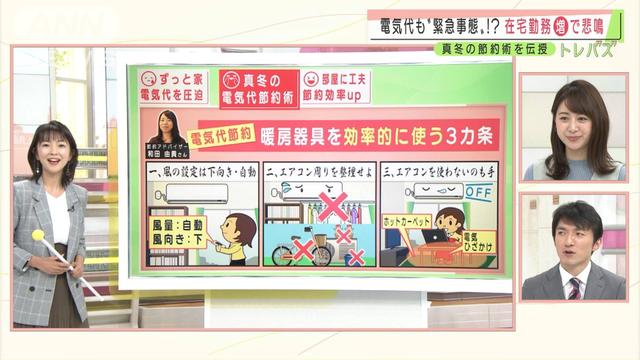How to save "heating costs" that you lose if you don't know 3 easy points
December is coming soon. It's the season to feel the arrival of winter. Saving heating costs is likely to be a major issue for households this season.
With the rise in prices of crude oil and liquefied natural gas (LNG), the prices of gasoline, kerosene, electricity and gas are also rising. The electricity prices for households in December announced on October 28 by 10 major electric power companies nationwide are higher than in November. The prices of the four major city gas companies also increased in December, and the prices of all electric power and gas companies have increased for four consecutive months. Since there is a time lag of 3 to 5 months for fuel prices to be reflected in electricity and gas prices, fuel prices are still soaring, and it is expected that the upward trend will continue in the future.
Most of the energy used in homes in winter is heating. In the case of air-conditioner heating, even if the set temperature is lowered by 1 degree, the power consumption will be reduced by about 10%, so modest heating will greatly affect the saving of utility bills in winter. The standard room temperature for heating is 20 degrees (from "WARM BIZ" by the Ministry of the Environment).
In order to save heating costs, there are measures to use different heating appliances and what to wear, but the most important thing is to prepare the room environment for the most efficient heating. This time, we will introduce the points of saving heating costs while saving energy and staying warm.
Do not let the heat escape
Even if you turn on the heating, it is meaningless unless you keep the warm air in the room. For that purpose, it is necessary to prevent the outflow of warm air and the inflow of cold air from the outside.
The warm air of the room flows out from various parts such as windows, walls, floors, and ceilings, but in particular, the outflow from windows accounts for about 50% of the total, so it is essential to take measures against windows.
Remodeling to a multi-layer sash or double sash (there are also systems such as subsidies and subsidies from the national and local governments) will have a great effect, but as a simple measure, replace the curtain with a thick one, or use a double sash. There are methods such as attaching a heat insulating sheet to the window. It is also effective to place styrofoam, plastic cardboard, commercially available cold protection panels, etc. on the window frame to prevent cold air.
As for measures with curtains, pay attention to the length. Cold air is heavier than warm air, so cold air goes to the floor. If there is a gap, the cold air in the space between the window and the curtain will flow into the room as it is and cause the cold air to accumulate on the floor.
For sweep-out windows, the curtains should be long enough to drag to the floor. If the length is not enough, adjust the length of the curtain hook to make it longer, or attach a short cafe curtain sold at 100 average to the hem of the curtain with double-sided tape. You can get the length of the curtain. In the case of a tall window, it is recommended to make it long enough to cover the window, and fix it to the window frame without fluttering the hem of the curtain under the window, or place styrofoam or a commercially available cold protection panel on the window frame.


Don't forget to take measures to prevent the inflow of cold air at the same time as preventing the outflow of warm air. Place your hand in the gaps around the interior doors, sliding doors, bran, and outlet boxes to see if you feel cold. If you feel cold, use a gap tape sold at 100-yen shops or home improvement stores to close it.
When the living room and kitchen are in the same room as in LDK, if you turn on the ventilation fan during cooking, warm air will be sucked out from the ventilation fan, and cold air will flow in through the gap, and the temperature of the entire room will often drop. To avoid this, when turning on the ventilation fan, try opening the window near the ventilation fan just a little. Then, although the outside cold air enters through the window, air circulation occurs between the window and the ventilation fan, which prevents the warm air in the room from being sucked out from the ventilation fan.
Keep humidity
Humidity is closely related to the sensible temperature. When the temperature is 10 degrees or higher, the higher the humidity, the warmer it feels, so even if the temperature is the same, it will be harder to feel warm when it is dry. In winter, especially on the Pacific side, it is very easy to dry, but raising the humidity to raise the sensible temperature also saves heating costs.
If the room temperature rises while the amount of water vapor contained in the air is the same, the humidity will drop relatively, so turning on the heating will make it easier to dry. Particular attention should be paid to air conditioners and floor heating. Generally, in the case of oil and gas heaters, the combustion of fuel produces carbon dioxide and water vapor, which pollutes the air but increases the humidity to some extent. However, in the case of air conditioner heating and floor heating, fuel is not burned, so only the room temperature rises and the humidity drops. Some models of air conditioners can heat while humidifying, but in most cases humidification is required.
Humidification can be done by drying the laundry indoors, but it is safe to use a humidifier to maintain stable humidity. However, excessive humidification may cause condensation and mold, so place a hygrometer in the room to control the humidity.
Install the hygrometer at a height about the line of sight of a person, avoiding places near windows, near doors, and where the wind from the heater directly hits. Appropriate humidity is about 45-60%. Ideally, you should keep at least 40%.
Eliminate the temperature difference between the top and bottom
Warm air is light and cold air is heavy. When the air conditioner or fan heater is turned on in the room, the warm air blown out becomes an updraft and the air cooled by the window becomes a downdraft and flows to the floor. The phenomenon in which the temperature difference between the top and bottom of the room increases in this way is called the "cold draft phenomenon," which reduces heating efficiency and adversely affects health.
Air agitation is effective in eliminating this. Use a circulator or a fan to send the wind from the window side of the room toward the ceiling. If the wind hits the window, the warm air will cool down, so be careful of the direction.
In addition, the circulator is more suitable for agitating air because the straight wind reaches far and the neck can be oriented freely. When using an electric fan, I think that many models do not have their neck facing up, so it is best to place it on furniture.
******
According to the Ministry of Economy, Trade and Industry, the outlook for electricity supply and demand this winter is expected to be the toughest in the last decade. Not only to reduce the burden on households as much as possible, but also to respond to the tight supply and demand of electricity, let's try to save heating costs this winter.




![[EV's simple question ③] What is good for KWH, which represents the performance of the battery?What is the difference from AH?-WEB motor magazine](https://website-google-hk.oss-cn-hongkong.aliyuncs.com/drawing/article_results_9/2022/3/9/b2506c4670f9f2cb45ffa076613c6b7d_0.jpeg)
![[How cool is the 10,000 yen range?] 1st: The performance of the "robot vacuum cleaner with water wiping function (19800 yen)" like Rumba is ...](https://website-google-hk.oss-cn-hongkong.aliyuncs.com/drawing/article_results_9/2022/3/25/5251bb14105c2bfd254c68a1386b7047_0.jpeg)

